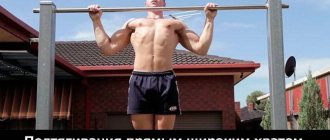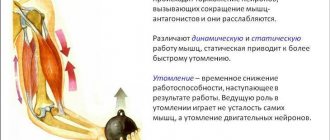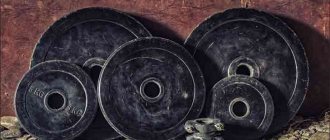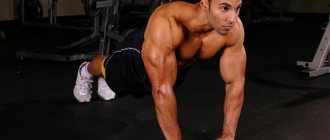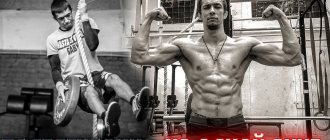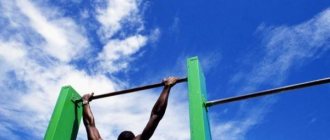Pull-ups and push-ups. Types of pull-ups and push-ups training programs.
Push-up program.
How to create a home push-up program to achieve results and growth of the pectoral muscles? How often and how many times should you do push-ups? How many times do you need to do push-ups?
Contrary to frequent advice, doing push-ups more than 15 times is ineffective - after all, in this case you are not working on muscle strength, and, especially, volume, but on endurance. Additionally, doing too many repetitions can burn your muscles.
Remember that the maximum that the muscles need is 4 sets of 12 repetitions. You do not need to increase the number of push-ups, but work on the technique and on complicating the movement - switch to push-ups on a platform and on one hand.
What muscles work during push-ups?
Depending on the type of push-up, the muscles involved vary. For example, during the classic exercise, the chest muscles are primarily involved in the work, part of the load falls on the triceps, and very little on the abs and back.
By changing the position of your hands, you can change the load on different muscles, and target either the chest muscles (wide arms position) or the triceps (narrow arm position. Additionally, push-ups on your fingers or fists strengthen the wrist.
Load when pushing up from the floor.
Research in the Journal of Strength and Conditioning Research (1) found that regular push-ups lift 64% of your body weight, while knee push-ups lift 49%. In other words, if you weigh 70 kg, then when doing push-ups you are working with 45 kg.
For a beginner, it’s not bad at all to start with 35 kg (push-ups on your knees), then move on to 45 kg. But, unfortunately, very soon you will need to increase the load. Those who go to the gym will tell you that bench pressing 45 kg is not that much.
Is it possible to increase the load when doing push-ups?
Only if you use a footrest will you increase the load. The same study says that using a 60 cm stand under your feet increases the load by up to 75% of your body weight. Alternatively, you can do one-arm push-ups.
Another way to increase the resistance of push-ups is to use additional weight placed on your back. Unfortunately, this is only possible with the help of a training partner - it is difficult to place the weight on your back yourself.
How to pump up your pectoral muscles at home?
Professional trainers recommend push-ups only to those who have never done strength training 2. Those who are fully involved in fitness can use push-ups more as a means of keeping fit without exercise equipment - for example, on vacation.
It is important that those who seriously work out in the gym do not need to add this exercise to their main program. Remember that doing 100 push-ups every day does not pump up your chest, but only worsens the recovery process after training.
Push-ups - program.
Let me emphasize again - push-ups are only needed for those who have never done strength training. They are useless as part of a program. In addition, you don’t need to burn yourself out with hundreds of repetitions. 4 sets of 12 reps is more than enough.
Start with an easy type of push-up, the push-up type, then move on to knee push-ups, regular push-ups, push-ups, and one-arm push-ups (or weighted push-ups. Also, train no more than three times a week.
How to do push-ups correctly?
To do push-ups correctly, you must learn to feel your chest muscles: stand up straight, press the front of your hand to your chest, then slowly move your hand forward, as if pushing something away from you, trying to tighten your chest muscles.
Repeat the movement over and over again, feeling the pectoral muscles engage. You can place your other hand on your chest to feel it better. The next step is to slowly push up from your knees, again with complete muscle control.
Despite popular belief, push-ups are not a magical exercise. It can be useful for beginners or those who want to stay in shape outside the gym, but it absolutely does not need to be included in the main training program.
Training programs on the horizontal bar.
The presented methods and training programs on the horizontal bar are based on such a basic exercise as pull-ups. Bar training and pull-ups are truly effective in helping you gain muscle mass and increase strength.
Pull-up pattern number 1 is the maximum effort method.
This pull-up program is very simple, and at the same time very tough. It should not be performed too often, but upon completion of the scheme, you will understand that the training was not in vain.
The program consists of 5 approaches with the maximum number of pull-ups, resting between approaches for no more than 3 minutes. Agree, it’s not very simple. However, if you want to approach this scheme more judiciously, then perform the training as follows:
1st set with 80% of the maximum number of pull-ups (for example, if you can do 10 pull-ups, then do 8 pull-ups in the first Set). 2nd set with 85% of the maximum number of pull-ups. 3rd set with 90% of the maximum number of pull-ups. 4th set with 95% of the maximum number of pull-ups. 5th set - the maximum number of pull-ups (in the last set, maximum effort is required from you, do not let go of the horizontal bar until all your strength leaves you). * Rest between Sets - no more than 3 minutes.
Note: It goes without saying that you should do a proper warm-up before starting your pull-up bar workout. Also, after completing pull-ups, do stretching exercises.
Pull-up pattern number 2 - 100 pull-ups in the shortest possible period of time.
This pull-up pattern is a good way to diversify your training program and truly “Surprise” your muscles. Also, if you're short on time but want to get a decent bar workout in, this circuit is a great option. Of course, it is not necessary to perform strictly 100 pull-ups; you can use other numbers as a guide, depending on your physical fitness. The idea is to perform as many pull-ups as possible in the shortest period of time, and the number of sets performed is completely irrelevant.
This training scheme can be performed in a variety of ways, for example, divided into sets of: 15, 13, 12, 12, 11, 10, 10, 9, 8 repetitions, in total = 100 pull-ups. Note: this training program was once practiced and recommended by Arnold Schwarzenegger.
Pull-up pattern number 3 - repeated load method.
This is another challenging plan for training on the horizontal bar, one might say ideal if you want to train with maximum efficiency. The presented pull-up scheme very effectively increases muscle strength and endurance.
The method of repeated loading is based on pull-ups with low intensity and a short rest period, giving a physiological impulse to apply more force.
Instructions: you need to perform 20-30% of the maximum number of pull-ups in one Set. So, if you can do 10 reps, then you should do 2-3 pull-ups in one Set.
Perform 2-3 pull-ups, then rest a little (about 10-30 seconds - the shorter the better) and proceed to the next set.
Perform the maximum number of approaches. The workout is over when you can no longer maintain perfect technique.
Note: With each new repetition, change the width or type of grip, such as reverse grip pull-ups (the more variety of pull-up techniques, the better.
Pull-up pattern number 4 - pyramid method.
An example of a program would be the following progressions: In steps of 1 - 1, 2, 3, 4, 5, 6, 7, 8, 9, 10, 9, 8, 7, 6, 5, 4, 3, 2, 1 = 100 pull-ups. In increments of 2 - 1, 2, 4, 6, 8, 10, 8, 6, 4, 2, 1 = 52 pull-ups. In increments of 3, etc., the top number can also be increased or, conversely, decreased. Rest for as long as you need to recover. Please note that this pull-up pattern already includes a “Warming Up” and “Cooling Down” stage.
Set of minor exercises
Despite the fact that you can achieve good results without iron, a set of strength exercises for men at home is a serious help that increases the efficiency of the process.
Usually, for a good figure and weight loss, it is enough to have set dumbbells up to 15 kg, and for a person’s basic weight of up to 70 kg, set dumbbells up to 12 kg are enough. Training always starts with the simplest exercises with reduced weight, which do not require much effort to warm up the muscles:
- The dumbbells are taken with both hands, after which the arms are bent at the elbow and brought to the shoulders at the same time. Next, with a slow movement, the arms are lowered again in a strictly vertical position.
- The position of the hands changes to a reverse grip, after which the hands should only be brought to 3/4. The main load from the biceps goes to the triceps and wrists.
Basic strength exercises at home for men are as follows:
- Divorce of hands. The body is held strictly vertical and with slow movements the arms are raised in different directions so that the position in space resembles the letter “T”, after which the arms are also slowly lowered. This exercise is characterized by increased complexity at the initial stage, so many people cannot do it even 10 times.
- Shoulder pushes. Everyone chooses to work with 1 or 2 hands, which by and large does not affect the result. This exercise is one of the basic ones for any strength sport. When doing this, you need to make sure that the metal does not hit your shoulders, because this can lead to injuries, and when the skin is broken, a small infection can occur (not dangerous, but it mars a comfortable life).
- Endurance exercise. This strength exercise is used for sports not as a way to build muscle mass, but to increase the efficiency of muscle work - arms with dumbbells are raised to the chest, then slowly alternately moved forward and folded again.
All physical exercises that are performed with your body weight can be performed with iron in your hands.
Elements of strength sports will increase their effectiveness, but will also add certain risks. Any strength exercise is performed from 10 to 30 times in 5 approaches - this will allow you not to overstrain the body once again, but keep it under maximum tension throughout the entire workout.
Types of pull-ups and push-ups. Types of pull-ups
Types of pull-ups on the horizontal bar are classified according to the alternation of phases, whether they are performed with or without weights, but the most important criterion is the execution technique and how you hold onto the bar (grip). Grips, in turn, are classified according to two main characteristics - distance and grip methods.
Types by distance between grips
The distance between the grips is of the following types:
- narrow grip - when the distance between the grips of the athlete’s hands is less than the width of his shoulders;
- medium grip - the distance between the hands is equal to the width of the shoulders, maybe slightly wider;
- A wide grip is when your hands are placed more than shoulder-width apart.
Classification according to the method of gripping the crossbar
The capture methods are as follows:
- straight or overhand grip - the athlete’s palms are directed in the direction opposite to his face;
- reverse or bottom grip - the crossbar is grabbed from below and the palms look into the face of the person pulling up;
- neutral or parallel grip - the hands are turned inward and the palms are facing each other.
By changing the way you grip the horizontal bar, you can concentrate the load on different muscles. The load is distributed most evenly across all involved muscle groups with a classic straight grip with an average distance between the hands. Pull-ups on the horizontal bar with a wide grip load the back muscles. The reverse grip puts more strain on the biceps. A narrow straight line also puts a lot of stress on the shoulder muscles. Pull-ups on the horizontal bar should be done with weights.
Types by technique
Pull-ups on the horizontal bar are aimed at the functional development of all muscles of the body, so it has firmly entered the CrossFit training system, becoming its integral component.
In CrossFit, along with the classic ones, the following types of this exercise are used:
Their techniques are very similar and in most cases are performed using inertial movements. If in the classic version of pull-ups the exercise is performed with motionless lower limbs and only due to the contraction of different muscle groups, then in kipping or butterfly the athlete makes swinging movements and, by inertia, lifts the upper body over the bar.
According to reviews, kipping pull-ups, for example, are easier than classic ones, but if the technique is incorrect, they are more dangerous. More detailed information about the techniques for performing each of these exercises can be found on our website.
Multifunctional wall horizontal bar
The “3 in 1: horizontal bar-parallels-abs” exercise machine is well suited for home training. The design allows you to work out the entire upper body - arms, back, shoulders, chest, abs. Wide, medium, narrow 45° and parallel grip options (multi-grip) are available.
To install, you need to drill 8 holes in the wall. Metal hooks will be screwed onto every two, which will become fasteners for the projectile. When changing the position of the horizontal bar, the athlete gets access to different exercises.
The advantages of a combined horizontal bar include a removable design and a relatively low price (compared to a similar floor exercise machine).
The equipment will be appreciated by martial arts athletes, as it can be used both as an arm trainer and as a mount for a punching bag. More expensive models are equipped with a block mechanism and a counterweight for performing traction exercises.
The only downside can be the low quality of the simulator itself. Therefore, before purchasing, be sure to inspect all parts for defects. First of all, pay attention to the mounting hooks. The metal thickness of the brackets must be at least 2 mm. Otherwise, they may not be able to support your body weight, which will inevitably lead to a fall.
Price examples: “Borabo 02007b” – 5400 rubles, “Profi Atlet” – 3000 rubles, “Ural Sport” – 2500 rubles.
Training program with push-ups and pull-ups.
Program of horizontal bar-parallels-push-ups + press
The program is designed for training 4 times a week - 2 hard workouts and 2 light workouts. An example of a daily class schedule: Mon (heavy) - Tue (light) - Thu (heavy) - Fri (light). Wed. Sat. and Sun. - days of rest.
You can practice it regardless of your level of training, changing the number of repetitions in each approach in accordance with your skills and changing the rest time between exercises. That is, the lower your level of physical fitness and endurance, the fewer approaches you need to perform, and the rest time you need to increase. Perform 4 sets of each exercise with the maximum number of repetitions. In approaches 1–3, you should have enough strength left for one more repetition. In the fourth, we do it to failure.
Program for horizontal bars, parallel bars and push-ups + press
Day 1.
- Pull-ups with a straight grip, shoulder-width apart.
- Chest style dips (elbows to the sides, body tilted forward 5-10 degrees)
- Pull-ups behind the head with a wide grip (2 shoulder widths)
- Push-ups with hands wider than shoulder-width apart.
- Raising legs while hanging on the bar.
- Leg raises on parallel bars.
Day 2.
- Push-ups from the floor, hands shoulder-width apart.
- Push-ups with arms wide apart.
- Palms together push-ups (palms form a diamond shape with each other)
- Raising your legs from a supine position.
- Bicycle lying on your back.
- Twisting.
Day 3.
- Pull-ups with a reverse grip, shoulder-width apart.
- Triceps dips (arms pressed, body slightly tilted back)
- Reverse grip pull-ups with narrow arms (distance between palms 1 fist)
- Push-ups with fists, hands shoulder-width apart.
- Raising your knees to your shoulders while hanging on the bar.
- Leg raises on parallel bars.
Day 4.
- Push-ups from the floor at shoulder width.
- Push-ups on the floor with fists, arms along the body.
- Push-ups, palms together (palms form a diamond with each other).
- Raising the body from a lying position in opposite directions (working with the oblique abdominal muscles).
- Raising your legs from a supine position.
- Twisting.
Pull-ups and push-ups. Pull-ups: technique of execution
Pull-ups require more effort than push-ups, so proper form is usually more difficult to perform. Without sufficient strength in their arms and back, people involuntarily begin to help themselves by jerking and swinging, using their legs, and do not lift their body enough. As a result, the wrong technique takes root, and the muscles of the back and arms do not receive sufficient load, and training is wasted.
Push-ups, pull-ups, squats, jumping rope and most other exercises have one fundamental thing in common: they give noticeable positive dynamics and effect only when performed correctly. By neglecting technology, a person robs himself, exchanging precious time and effort for trivial results.
Starting position when pulling up:
- The palms tightly grip the horizontal bar using one of the grip options. Arms are fully straightened. The abs are tense. Legs crossed. The body hangs freely on the horizontal bar.
- Grips. With a straight grip, the palms are directed outward in relation to the face, the main load goes to the middle part of the latissimus muscle, the anterior serratus and triceps. With a reverse grip, the palms are directed towards the face, the load falls on the lower part of the latissimus muscle and biceps. A wide grip shifts the main force to the back, a narrow grip to the chest muscles, and a medium grip to distribute the force evenly.
Performance:
- Using the strength of your arms and back, smoothly lift your torso up, without jerking your body or jerking your legs. Touch the bar with your upper chest, fix your body for one or two seconds and smoothly, but without relaxing your muscles, lower your body to the starting position. Elbows should not rise above the horizontal bar.
- Breath. Inhale when lifting the body, exhale when the body lowers.
The benefits of pull-ups
Exercising on the horizontal bar allows you to improve your posture and overall health of the body in the shortest possible time. And besides this, training on the horizontal bar has many advantages:
- Exercising on the horizontal bar can easily replace any medication and can act as a prophylactic against all kinds of diseases and weaknesses. And they can also prevent any diseases related to physical health. A sedentary lifestyle can lead to stagnation of the body, and exercise on the horizontal bar can maintain health. To do this, just hang on the crossbar every morning, or do exercises. Of course, you can’t exercise regularly, but practicing every day for 10-15 minutes is much more effective.
- If you hang on the horizontal bar regularly, you can get rid of tension in the spine , which accumulates throughout the day. The spine will stretch, all the muscles of the body will gradually relax, and the back muscles will stretch. This exercise is recommended for people who have problems with the musculoskeletal system and intervertebral discs.
- When doing pull-ups on the horizontal bar, a person puts a heavy load on the cardiovascular and respiratory systems. It is because of this that you need to do the exercise correctly in order to heal the body, and not ruin it. First, you need to do pull-ups without any additional techniques in order to avoid serious problems. Any additional items that act as cargo are allowed to be taken only after some time.
- You should exercise on the horizontal bar in order to strengthen the muscles of the whole body . Weight training can increase muscle mass and strength capabilities.
Table of push-ups and pull-ups. Reverse and forward progression method
This table of pull-ups on the horizontal bar will help you achieve the desired result; you will be able to do at least 25 pull-ups.
Reverse progression method
You need to do pull-ups for 6 days; on the 7th, be sure to take a break from physical activity. You need to practice for 4 weeks, constantly changing your grip. In week 5, continue the training program using the direct progression method. Then you should return to the first version of the program.
Method diagram in table form
The presented training program is designed for beginners; in 5 weeks you can easily reach 25 times in 3 approaches. Those who have a standard significantly higher than the presented amount can catch up by doubling all the numbers in the table. This way you can learn to do it 30, 50 and 100 times, the main thing is desire and regular training.
There are two types of grip in pull-ups - forward and reverse.
With a direct grip, the fingers of the hands move away from you, with a reverse grip, they move towards you. If the hands are located at shoulder level - a narrow grip, 10 cm wider - medium, and if they are spread as far apart as possible - a wide grip.
Pull-ups or push-ups: which is better?
Pull-ups and push-ups are the most basic exercises. Every athlete began his journey with these exercises. And any professional athlete will say that these are the best exercises for a beginner and this is where you should start your journey in sports.
Push ups
Push-ups begin to be taught in physical education classes in kindergarten. And this continues further at school and in college.
Push-ups help strengthen your entire body.
To perform this exercise, you only need a flat surface. A large number of muscles are worked:
Of course, each individual muscle works, to one degree or another. And the load can be varied. Achieving great results is quite simple. After all, no additions are needed.
Pull-ups
It is also a basic exercise and is included in the physical education curriculum. To perform this, you need a horizontal bar, which can be found on any sports ground.
Muscles worked during pull-ups:
Of course, this is not a complete list, because many more muscles are indirectly involved in the work.
Pull-ups require more skill and strength than push-ups. But this only adds advantages to it.
Where to begin?
You can argue about the merits of these exercises for a long time. Each of them has its pros and cons.
In push-ups, it is the chest muscles that work to a greater extent. By changing the position of your hands you can achieve more work. The remaining muscles work as auxiliary muscles. The main advantage, of course, is that there is no need for additional equipment and equipment.
When doing pull-ups, the back muscles receive the main load. And by also changing the position of the hands and grips, the load can be shifted to the hands. To perform pull-ups, you need a horizontal bar, which can cause some difficulties.
Of course, if we assume that the training will take place at home, then push-ups are the best exercise. If you train outside, then, of course, it’s worth conquering the horizontal bar.
Combining exercises
In order to achieve greater results and increase your performance in both strength and muscle volume, it will be better to combine these exercises. This will help you work out your entire upper body better.
To begin with, you can divide your workouts by day. Do pull-ups one day, push-ups the other. As the muscles get used to the load, each time the workouts will seem easier and easier.
Next, you should try doing two exercises in one day. There are options here too. For example, do push-ups in the morning and pull-ups in the evening, or vice versa. You can do this in one workout. You should try to perform the exercises one after another in one approach. Or do a few sets of push-ups, then a few sets of pull-ups.
There are enough options to choose from. And if you come up with something new every time, it will diversify your training. The main thing is not to let the body muscles get used to the same load, but to constantly vary it. You should also add squats to your workouts in the future. This will help to finally consolidate the result and work out the whole body. After all, a beautiful body is not only big arms, a wide back and chest. The body must be developed proportionally. An athletic physique adds confidence in yourself and your capabilities.
Varieties
There are a variety of exercise machines with which you can easily do pull-ups at home and develop your back and arm muscles well. The most popular among beginners are those that are designed not only for pull-ups, but also for push-ups.
This way, you can do several types of exercises with one device (for example, Graviton can be a great help here). With such horizontal bars you can perform the most common exercises: pull-ups with a narrow and wide grip.
There are also special exercise machines that are equipped with special weights. As a rule, such devices are often equipped with several types of pull-up handles so that you can develop your back and arms well. Also, some manufacturers make entire walls, which necessarily include a pull-up machine.
Push-up pattern, pull-up pattern. Pull-up and push-up programs
The horizontal bar is one of the simplest, most accessible and effective equipment for those who want to improve their physical fitness on their own. The correct pull-up technique on the horizontal bar will help you work out a whole group of muscles, from the back to the abs.
If doing pull-ups a couple of times on the horizontal bar is no longer a problem for you, then you can move on to the next stage - increasing the number of pull-ups. Stick with this regimen for thirty weeks, and you are guaranteed to be able to do 30 pull-ups, and possibly more. It all depends on your desire. Exercise on the horizontal bar 6 days a week, make the seventh a day off. Rest between pull-ups for 2-3 minutes.
Program to increase the number of pull-ups and push-ups in 15 weeks
Floor horizontal bar
It is a rack for pull-ups and dips. The structure consists of two vertical metal supports, which have reliable stands at the bottom and are fastened at the top with a horizontal crossbar. In the center there is a soft pillow for the back and two handles for push-ups. The simulator is collapsible, so there will be no problems with transportation and installation in the apartment.
The main advantage of such a projectile is its versatility. The athlete has access to all types of pull-ups, dips, and leg raises.
The design does not involve mounting to the wall, which will be appreciated by people with expensive repairs. Some models of exercise machines are additionally equipped with expanders and even bench presses, which qualitatively expands the possibilities.
There are two downsides: cost and size. When choosing a horizontal bar stand, check the availability of parts and bolts. Pay attention to the quality of the metal. It shouldn't be thin. Consult your dealer for weight ratings. We recommend that tall people choose models with adjustable height.
Price examples: “Leco Home It” – 7,000 rubles, “DFC Power Tower G003” – 11,000 rubles, “Energetics PWT 30” – 13,500 rubles.
Pull-up push-up apparatus. Purpose and description
The 007-201 apparatus is a cascade of three bars, 2 of them are intended for pull-ups, and the other, the lowest, is for push-ups. 4 vertical posts and 3 horizontal crossbars - that’s all the “spare parts” of this projectile. However, the functionality of the equipment allows you to perform a huge variety of exercises both for workout and standard physical education at school. Key exercises for the 007-201 apparatus are pull-ups and push-ups. But as each of these elements becomes more complex, the athlete will gain excellent abdominal and arm muscles.
The support pillars are of different heights - from 500 to 1500 mm. 3 crossbars are located at a height of 400,900 and 1400 mm respectively. A steel clamp is used to fasten the elements, which allows you to adjust the height of each crossbar to the height of the athlete. A special anti-corrosion coating provides the push-up and pull-up bars with strength and durability of the steel in all weather conditions.
The overall dimensions of the cascade of crossbars 007-201 are 4000x160x1500 mm.
Bars or push-ups. Push-ups from the floor and on parallel bars.
I want to devote this article to dips and push-ups. First of all, I would like to write about how to learn to do push-ups on uneven bars.
To begin with, you should just try to do push-ups at least once, so to speak, test your strength, in case it won’t be too difficult for you.
If you can do push-ups at least a couple of times, that’s very good; you can say that not all is lost.
But, there is one rule in push-ups on the uneven bars; only those push-ups are considered correct - when your arms are bent 90 degrees at the elbow.
Something like this:
muscle dips
The photo shows which muscles are pumped best. The greatest load is placed on the chest and triceps. Therefore, these are exactly the muscle groups that you can pump up during dips.
If everything is very bad for you and you cannot do push-ups on the uneven bars, then you need to start training not with the uneven bars, but with regular push-ups from the floor. They are naturally much easier than on uneven bars, the result is not so great, but if you perform push-ups with full amplitude, then the effect is also very good, no worse than uneven bars. Therefore, for the first time, I advise you to simply do push-ups from the floor, about 50-100 times per workout, divided into about 5-10 approaches, whichever is more convenient for you.
Keep the interval short, about 1-2 minutes. Try to do push-ups correctly and lower yourself almost to the floor. You should place your hands slightly wider than your shoulders, so the load will be more on the chest; if you place your hands closer to each other, the maximum load will be on the triceps. You can combine as you think best, some want beautiful sculpted breasts, others vice versa. So see for yourself.
Here is an approximate diagram for push-ups from the floor, the more the better:
pushups
In dips, I advise you to do about 100-200 repetitions; I personally did up to about 200 push-ups per workout. I tried to break push-ups into a minimum number of repetitions, this way I trained endurance, and the effect of the training was greater.
Simply - simply, you squeeze out the maximum and thus the muscles are pumped better, more cells in the muscles are torn. But if you are a beginner, about 80-100 push-ups will be enough for you. Try to do as I did, break the repetitions into a minimum number of approaches, I think 7-8 approaches is enough for you to start with. And don’t forget to look at the quality of the push-ups; remember that correct push-ups are considered when the arm at the elbow is bent 90 degrees. The more you go down, the better your muscles will be!
Well, I'm good at push-ups. There is nothing complicated, you just need patience. And I assure you, the result will not keep you waiting!

